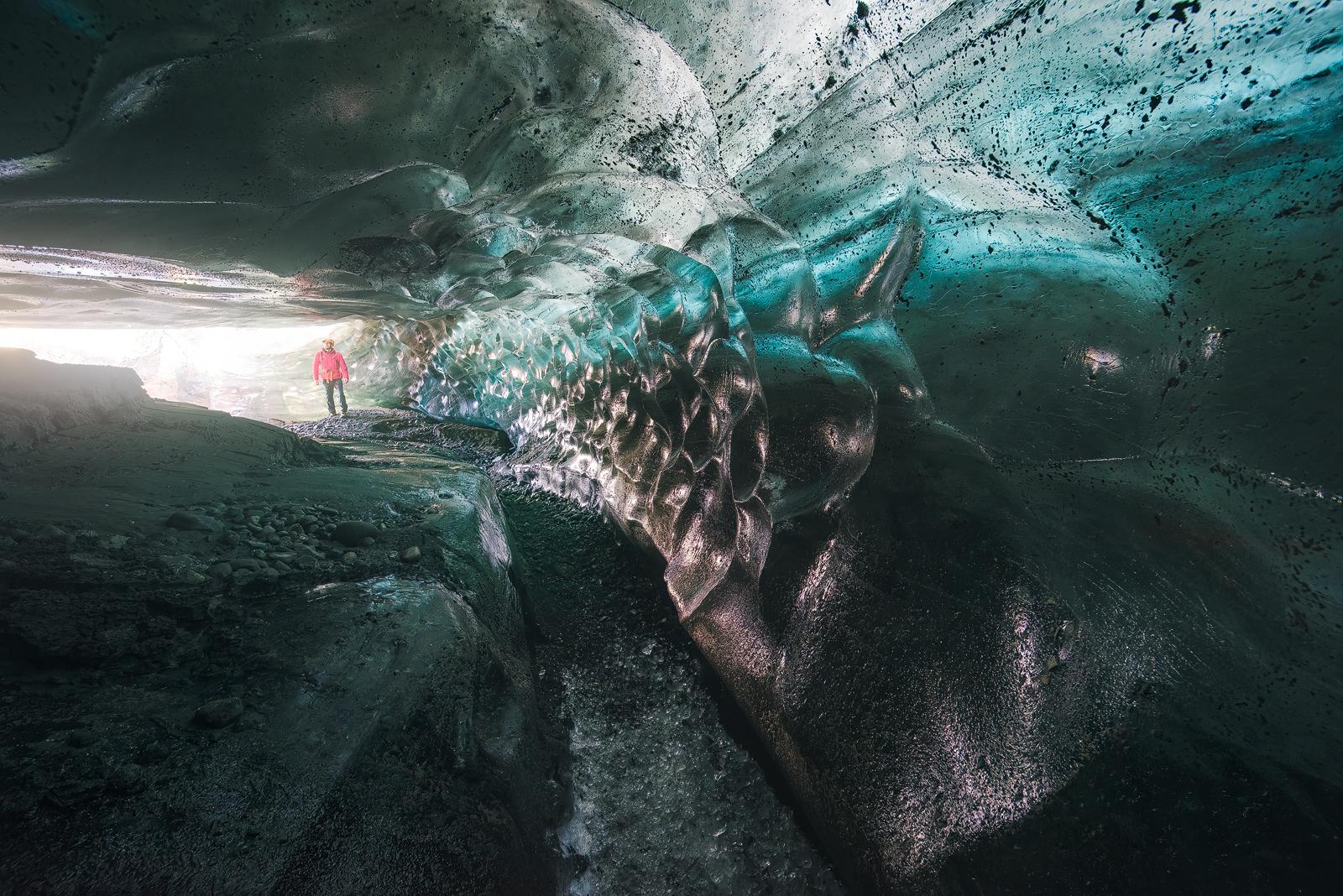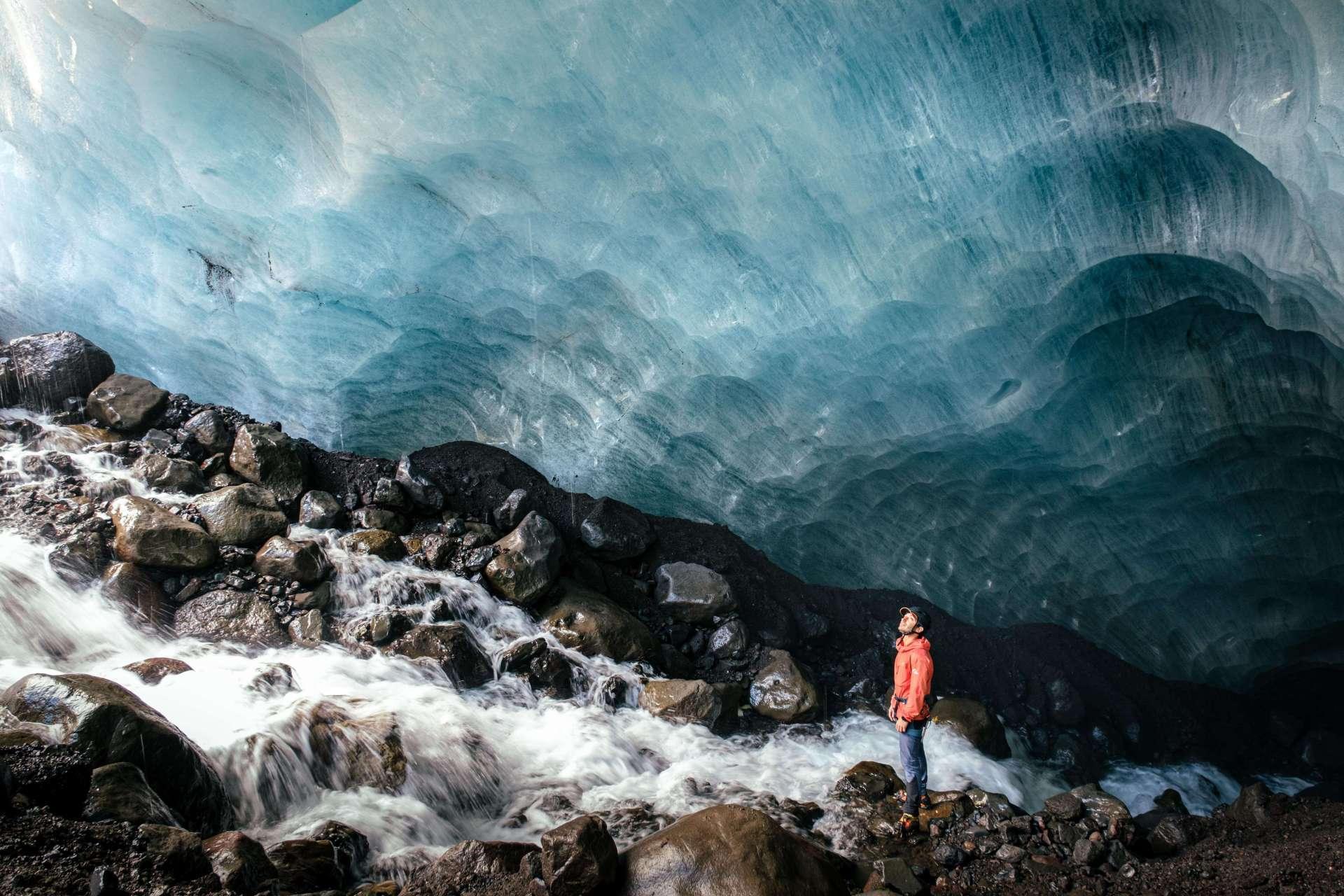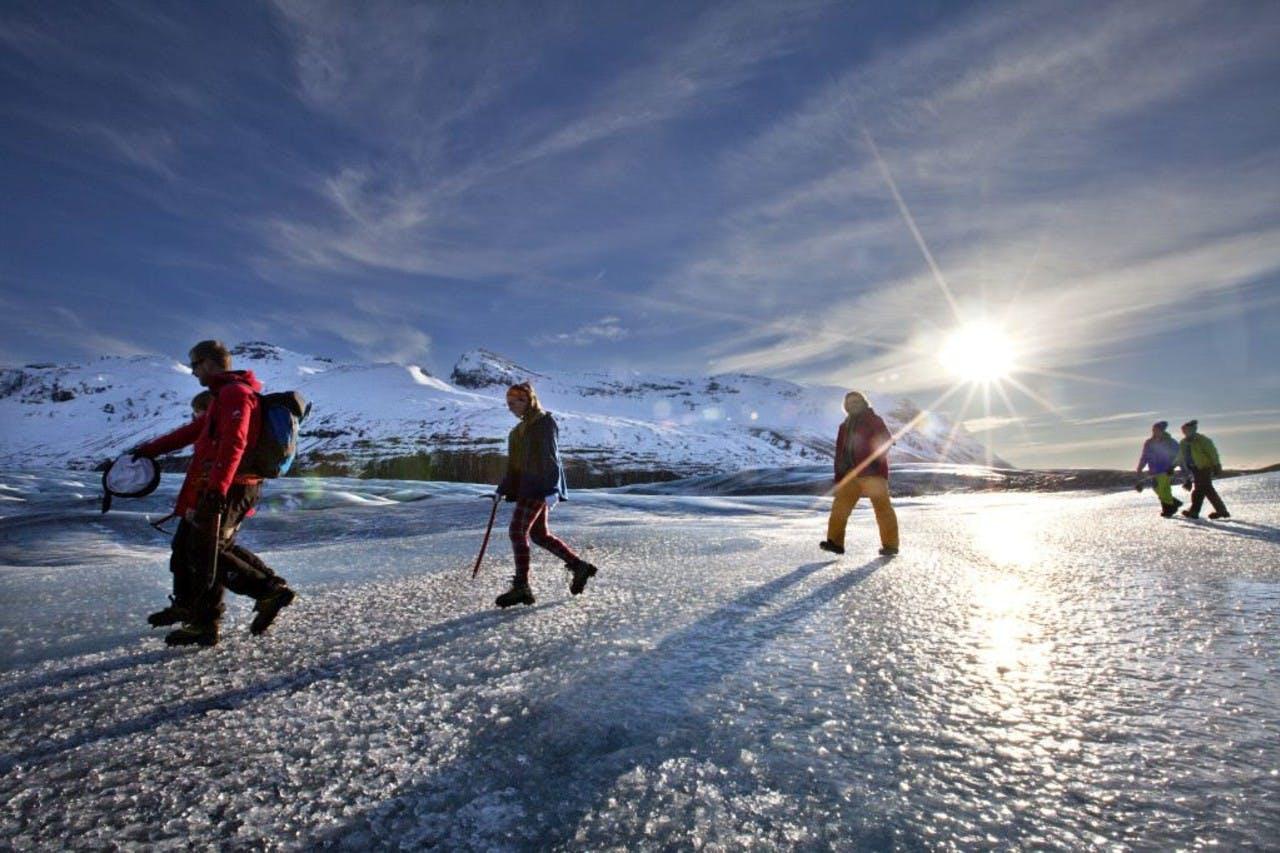Your guide to the Aurora Ice Cave Tour in Iceland
| DISCOVER ICELAND, glaciers, Ice Caves
Outside Aurora Cave the northern lights are dancing across the sky, displaying a spectacle of colour from ice-blue to silvered mint and electric green. Inside the cave, it’s as if the northern lights have seeped in, echoing the glowing hues outdoors. It’s heaven on earth when this happens, if you’ll excuse the pun. But even if the aurora doesn’t make an appearance, the shimmering colours inside Aurora Cave are guaranteed. And this is an experience that will stay with you forever.
The cave was discovered and named by two guides exploring the glacier of Vatnajökull beneath the northern lights. Walking into the mouth of the cavern, it seemed like the aurora had followed them in. Scientifically, of course, this incredible phenomenon is created by the scattering of white light through the ice into a spectrum of colour. But it’s magical just the same. You too can discover the dreamy colours of the cave for yourself with the Icelandic Mountain Guides Aurora Ice Cave Tour in Iceland.
Visiting Iceland in winter is a ‘Narnia’ experience, the fells covered in snow and ice, the northern lights glowing an eerie green with hues of pink and violet. Underground, the glacial caves are like ice palaces, a magical subterranean playground for cave visitors. If you haven’t thought of visiting Iceland in winter, think again - and above all - visit Aurora Ice Cave.
About the Aurora Ice Cave tour
The adventure begins at Jökulsárlón, a vast area of glistening glacial ice and floating icebergs in an enclosed bay of blue. Join the Aurora Ice Cave Tour with experienced guides who will provide you with all the safety equipment you need. Meet your guides at the blue Icelandic Mountain Guides trailer at the car park west of Glacier Lagoon. They will take you, weather permitting, to the cave on an adventurous thirty-minute truck drive. Book your trip now and explore one of Iceland’s most enchanting caves.
About Jökulsárlón Glacier Lagoon
The Jökulsárlón Glacier Lagoon, close to the starting point for the Aurora Cave Tour, is a place of indescribable beauty. At its deepest, the lagoon is 248 metres (814 feet) and its waters extend over eighteen square kilometres (eleven square miles). But cold figures don’t even begin to conjure up the thrill of standing on the shores of Jökulsárlón - the glacial runway of Vatnajökull at one end, the waters of the lagoon’s narrow neck at the other, flowing out to Diamond Beach. In between, the vivid blue waters are littered with ice floes. Close up, they look like ice-monsters, all jutting jaws, hooked noses and crabbed claws. Others look like pale spaceships lying low on the water.
Pick up a small piece of ice in your hand and let it melt, then cup your hands to drink. It will more than likely be the oldest drink you’ve ever had! The icebergs of Jökulsárlón are composed of ice over a thousand years old.
Dropping down towards Diamond Beach, you may catch sight of the seals that flock to the mouth of the lagoon in winter - their fishing grounds. On the pebbled shore, more icebergs bob out to sea, tossed and kicked along the surf like footballs. Others are shored up on the stones, their translucent, sometimes transparent ice, sculpted into weird and wonderful crystalline shapes.
Jökulsárlón is a five-hour drive from the capital of Reykjavik, but it’s worth every single one of the 380 kilometres.
Northern lights in Iceland
‘Aurora’ - a word that conjures up enchantment and a kaleidoscope of colour. The Aurora Cave is an echo of one of Iceland’s greatest phenomena. In autumn and winter, there’s a good chance of seeing nature’s spectacular shows. Each September through to March, when nights are at their longest in Iceland, clear cloudless nights often put on a performance to outshine any man-made lightshow. The optimal time is around the winter solstice.
With little light pollution, Iceland’s skies offer perfect conditions for seeing the aurora in all its glistening glory. Solar activity in the northern skies brings about a dance of electrifying greens, purples and pinks, ribbons of colour fanning out across the night sky in throbbing colour.
As often with nature, you can’t arrange a time for the show. Patience is the name of the game. But you can increase your chances by booking a tour with Iceland’s experts, who follow the aurora forecasts carefully and are ready to spring into action. They know where the best places are for seeing the northern lights, and when. With Icelandic Mountain Guides Northern Lights Tours you can combine the aurora with adventure.

Ice caves in Iceland
So what are ice caves? And why is everyone talking about them?
An ice cave is any natural cave that has significant amounts of ice in it year-round. For this to happen, at least part of the cave has to have a constant temperature of 0℃, the water freezing on entering the cavern. The blues and white hues of ice caves combine with the colours of the cave itself: blacks, reds, charcoal and copper hues. They can be visited year-round.
Glacial caves are created by meltwater that seeps through crevasses to form channels beneath glaciers. They are formed completely within an ice mass. Some of the passageways carved out of the meltwaters under glaciers are as wide as ten metres - creating dazzling ice palaces in mesmerising shades of blue.
It’s the glacial caves most people think of when they hear the phrase ‘ice cave’, and it’s these stunning ice caverns that draw visitors to Iceland in winter. Most ice (glacial) cave tours offered in Iceland are at Vatnajökull and can only be visited in winter.
Frequently asked questions about Ice caves in Iceland
Where are the blue ice caves in Iceland?
The glacial caves of electric blue, deep violet and icy white are mostly found below Vatnajökull, Iceland’s largest ice-cap but not all. Tours generally depart from the car park by Jökulsárlón Lagoon in southeast Iceland.
When can I visit the blue ice caves of Iceland?
The caves are accessible between October and March, although many operators don’t begin their tours until November. Even then, access to the caves is weather-dependent. If a trip is cancelled, you will be refunded, and hopefully the trip can be rearranged.
Which ice cave tours are the best in Iceland?
Arguably, the Crystal Ice Cave, although all of the Vatnajökull glacial caves pack a punch. One of the largest in Vatnajökull National Park, the Crystal Ice Cave gets its name from the glassy walls of blue and white. And if agility is an issue for you, never fear - tour companies can drive right up to its entrance. By the way, the clarity of the crystalline ice is due to the ice-cave’s age - step back 1,200 years!
New glacial ice caves are appearing all the time in Iceland. The Blue Diamond Cave made its debut in Vatnajökull in 2016 - and what an appearance! It may be a lot smaller than the Crystal Ice Cave but what it lacks in size (it fits fewer than twenty people) it makes up for in beauty: the intense blue of its walls is even more vivid than the Crystal Cave.
You may recognise Katla Ice Cave from Star Wars, the ice cathedral formed by one of Iceland’s most notorious volcanoes. Inside, its impressive blue and black walls are dotted with bubbles. It’s found on the southern tip of Iceland, south and west of Vatnajökull.
How do I reach the volcanic caves of Katla?
Mountain Guides partner, Katlatrack, offers you a trip to the Secret Ice Cave on a small-group day trip from Reykjavik, hidden directly beneath the dormant volcano of Katla. On the way in, you’ll experience an otherworldly landscape of black sands and green-mossed mountains. Inside the cave, the luminous blue ice walls contrast the surrounding black ash. It’s a phenomenal sight. This trip combines the Secret Cave with the waterfalls Seljalandsfoss and Skógafoss. The tour crams a lot into one day but has you back in time for dinner in Reykjavik!
Can you recommend a tour for hardcore adventure in Iceland?
Mountain Guides offer a thrilling tour Ice Cave - Only the Brave. It takes a bit of effort to access the remote cave found on an outlet glacier near Skaftafell National Park. From Skaftafell base camp, next to the visitor centre, you’ll be taken into a frozen world of glacial ridges, deep crevasses and an ice cave of vivid colour.
Come equipped with warm and waterproof clothing, hiking boots, drinks and snacks and Mountain Guides will provide the rest: crampons, ice-pick, harness and helmet. You get the picture - this is a trip for the adrenaline junkie. Here is our detailed guide to what to wear on a glacier in Iceland.
Can you visit ice caves in Iceland on your own?
Not unless you are an experienced ice caver. Otherwise take a guide. Glacial ice caves are dangerous, constantly in flux and changing from one day to the next. Book a trip with an expert guide who is trained in safety and will provide you with all the equipment you need. The guide will - as the name suggests - guide you into the cave safely.
How long is an ice cave tour in Iceland?
The family-friendly Crystal Ice Cave tour takes around four hours with approximately an hour in the cave.
The easy Aurora Cave tour lasts three hours, the more challenging ‘Only the Brave’ tour five-and-a-half. The Secret Cave beneath Katja Glacier lasts from one-and-a half to two hours. For more information check out the Icelandic Mountain Guides Ice Cave Tours.
If you love northern winters, snow-covered mountains, frozen waterfalls, pure wilderness, stormy seas and caves of indescribable colours visit the Aurora Ice Cave in Iceland. To combine this colourful spectacle with the charged energy of the northern lights is an experience you’ll unlikely to forget.





Keep me informed about the Icelandic Mountain Guides Blog
Outdoor adventure in Iceland is our specialty. Subscribe to our free monthly newsletter to learn when to go, what to do and where to have the best adventures in Iceland.


